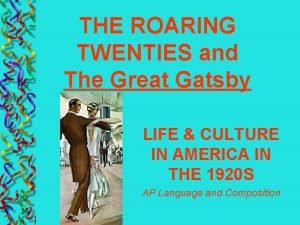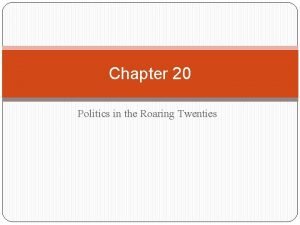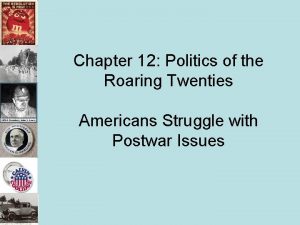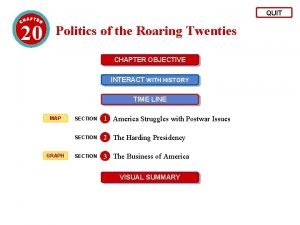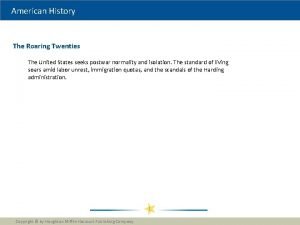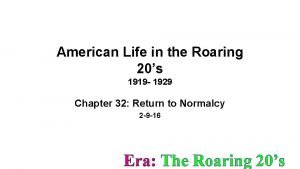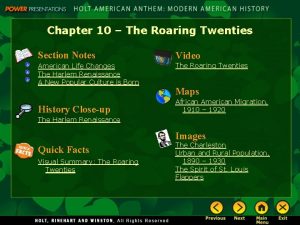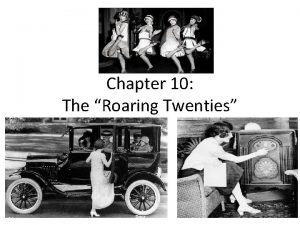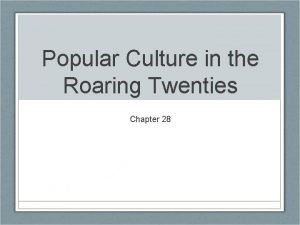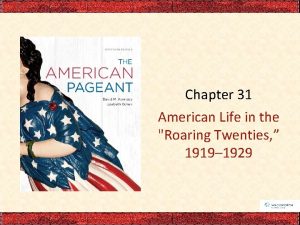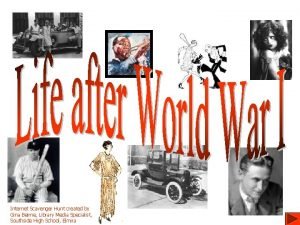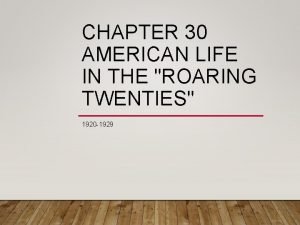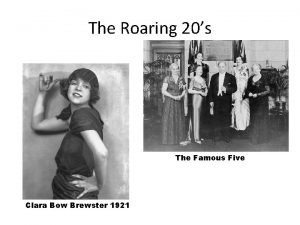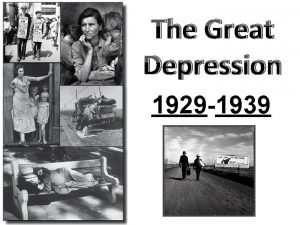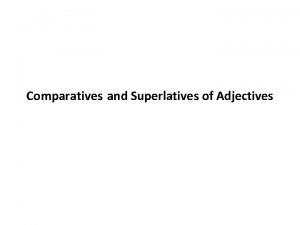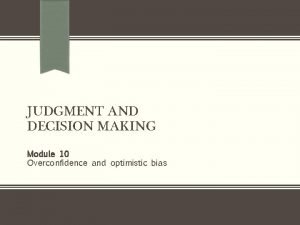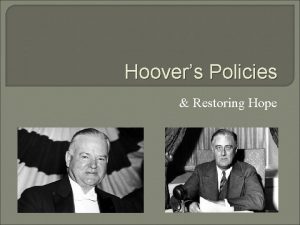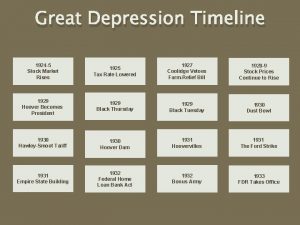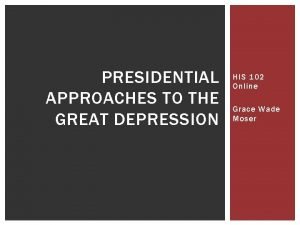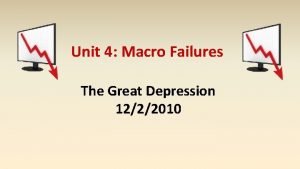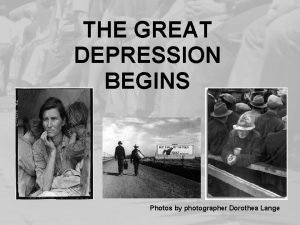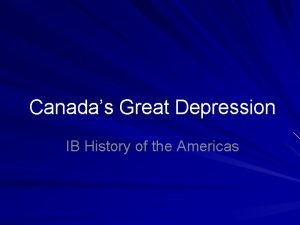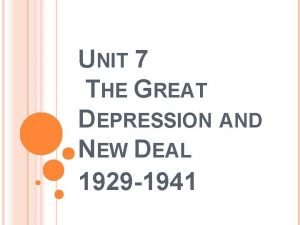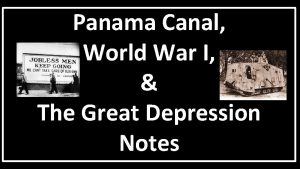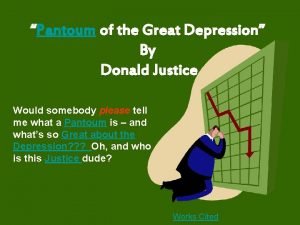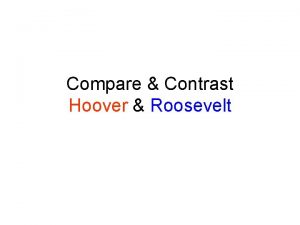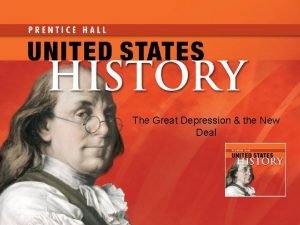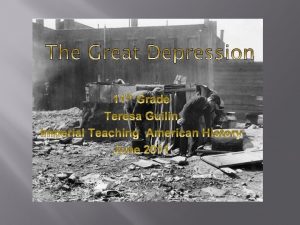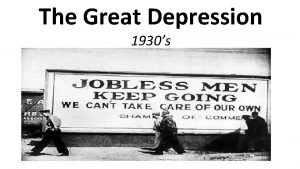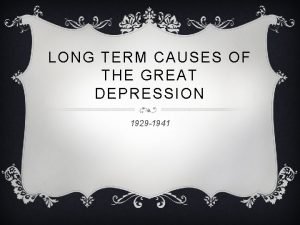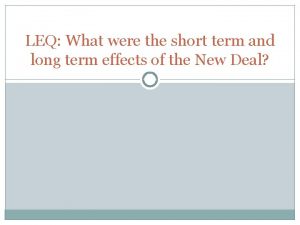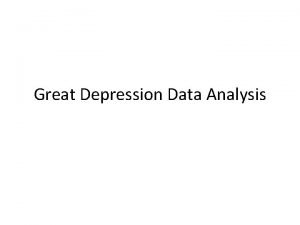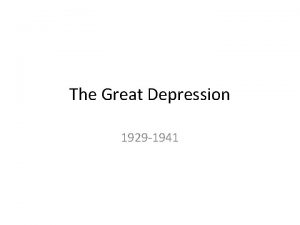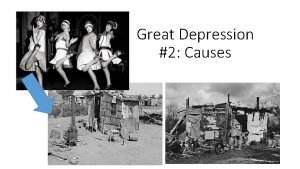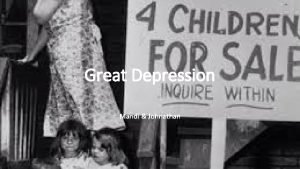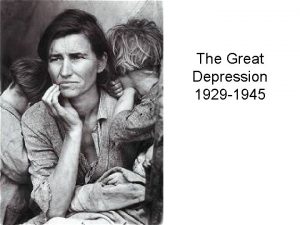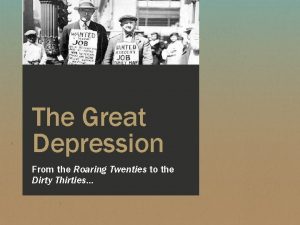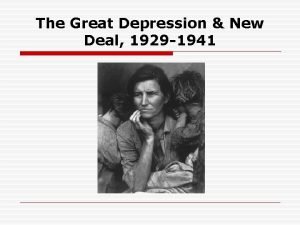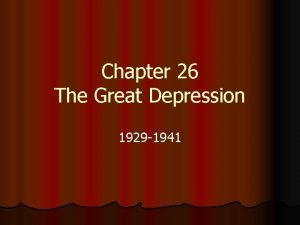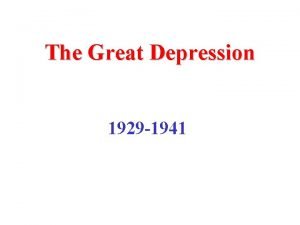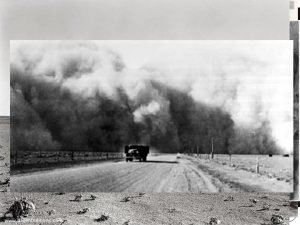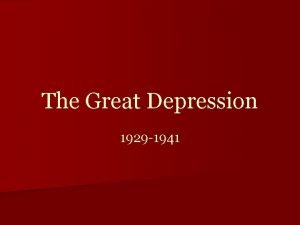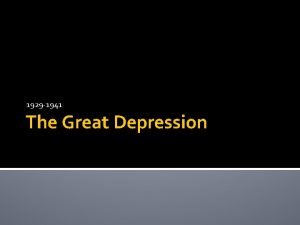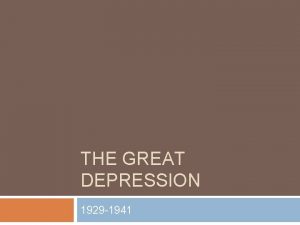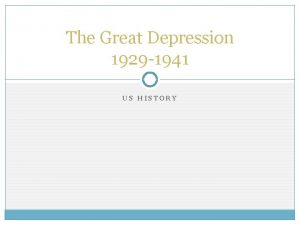The Great Depression 1929 1941 Roaring Twenties Optimistic



















































- Slides: 51

The Great Depression 1929 -1941

Roaring Twenties • Optimistic Time – Wealth and productivity – Medical advancements • Decrease in infant mortality • Life expectancies increased 10 years from 1900

Warren Harding (1921 -23) Calvin Coolidge (1923 -1929)


Main cause of collapse: hubris? • excessive pride or self-confidence; arrogance • “We in America today are nearer to the final triumph over poverty than ever before in the history of any land. The poor house is vanishing from among us. ” - Herbert Hoover, 1928

What accounted for severity? • • • Lack of Diversification Maldistribution of purchasing power Credit structure of economy America’s position in international trade International debt structure Protective tariffs

Warning signs: • Uneven wealth – In 1929 richest Americans (0. 1%) had held 34% of the country’s savings – 71% of individuals earned less than $2, 500 (minimum standard of living) – 200 largest companies controlled 49% of industry

Warning sings continued… • Rise in personal debt – Buying with credit (installment plans) • Radios, vacuums, refrigerators • 80% families had no savings, even though entire families were working

Overproduction • Rising Productivity • Wages Rose, but assembly lines produced goods too quickly • Caused some industries to slow – Automobile, housing • BUT… Stock market kept rising

Playing the Stock Market • Before WWI, only wealthy invested • After, “Get rich quick” attitude prevailed – Newspapers reported on ordinary people – Small investors bet life savings • Buying “on margin” – Buy stock for fraction of the price and borrow the rest

Stock Market Crash • By 1929, prices of stocks soared above their real value • Peaked in Sept. , then slowly declined • Tuesday, Oct. 29, 1929, investors raced to get their money out of the stock market • Initially, only affected investors – 1929 only 4 million of 120 million

Ripple Effects • • Risky loans hurt banks Consumer borrowing Bank runs Bank failures Savings wiped out Cuts in production Rise in unemployment Further cuts in production

Economic Effects (1930 -1933) • Collapse of Banks – 6, 000 bankrupt or closed – Depositors lost $2. 5 billion • Widespread unemployment – 15 million, 25% of workforce • Collapse of farm economy – By 1932, farm income down 60% – 2/3 of farm families lose land

Normal Business Cycle • Economic… – Expansion – Peak – Contraction – Trough • Recession vs. Depression – Depression = prolonged and severe

• Great Crash of 1929 triggered most severe depression in U. S. history • Great Depression (1929 -1941) • As for welfare capitalism – Henry Ford shut down Detroit auto factories – Put 75, 000 out of work • The GNP: $104 billion (1929) to $56 billion (1933)

Cycles of Depression • Investors and Businesses – Businesses lose profits, Investors lose $$$ • Businesses and Workers – Consumer spending drops, businesses cut investment and production (some fail), workers are laid off • Banks – Businesses and workers cannot repay loans, banks run out of money/fail, bank runs occur, savings accounts are wiped out

World Payments • • • Overall U. S. production plummets U. S. investors have little/no money to invest U. S. investments in Europe/Germany decline German war payments to Allies fall off Europeans cannot afford American goods Allies cannot pay debts to United States

Interdependent World • By 1930 s, international banking, manufacturing, trade connected nations – Latin American depended on U. S. for goods – Europe depended on U. S. loans/investment – U. S. was world’s leading economy • After WWI, Allies (France/G. B. ) relied on Germany’s reparations to repay U. S. – After market crash, U. S. stopped $ to Germany – German economy failed, Allies’ payments to U. S. ended

Great Depression Part II

President Hoover (1929 -1933)

Future 1 st Lady Lou Henry (age 17)

“Hoovervilles” • Shantytowns named for President Hoover

Sacramento, 2009

Social Effects • Hardships at all levels – Few prospects for laid off white-collar workers • Poorest hit hardest – Hunger, sickness, homelessness • Homeless/jobless became drifters – “hit the rails”

Farm Distress • Crop prices plummeted – Families could not pay mortgages/loans • Families lost farms to banks – Banks would auction farms off • In South, landowners expelled tenant farmers and sharecroppers

The Dust Bowl (1931 -1940) • Severe drought and over-farming – Severe soil erosion, soil (“dust”) clouds • Removal of prairie grasses exposed topsoil • Wind blew it for hundreds of miles – Cities in east had darkened skies – Reports of soil landing on ships in Atlantic


Dust Cloud Approaches Stratford, TX, 1935








“Okies” driving to California




• “Migrant Mother” by Dorothea Lange (1936)

Surviving the Depression • • Nothing wasted Planted “relief gardens” in cities Breadlines and soup kitchens widespread Farm families stuck together – Penny auctions • Millions left home to “ride the rails”

Americans took their failures personally • Widespread Shame – Especially w/ men who lost jobs • Many were embarrassed or too ashamed to accept charity • Discrimination – Nativism – Deportation – Higher unemployment in minority groups

Americans sought political solutions • In Europe, riots and political upheaval • Most Americans trusted democratic process • Communism and Socialism made small gains • Eventually, Americans blamed Hoover directly

Hoover’s Limited Strategy • Insisted on confidence in system • Blamed depression on world-wide crisis • Supported voluntary controls by industry – For example, to maintain min. wages • Hoover held rigidly to his plan (voluntary controls and confidence), and economy continued to worsen

Finally, The Government Acts • Began with govt. spending on public buildings, roads, parks, dams • Hawley-Smoot Tariff (1930) – Highest import tax in history – Backfired, Europeans raised their tariffs • Still, Hoover believed: – state and local govts should handle relief – direct federal assistance would destroy people’s self respect and create a large beaureacracy






 Roaring twenties great gatsby
Roaring twenties great gatsby Chapter 20 politics of the roaring twenties
Chapter 20 politics of the roaring twenties Chapter 20 politics of the roaring twenties answer key
Chapter 20 politics of the roaring twenties answer key Chapter 12 politics of the roaring twenties
Chapter 12 politics of the roaring twenties Chapter 20 politics of the roaring twenties answer key
Chapter 20 politics of the roaring twenties answer key The roaring twenties lesson 3 changing ways of life
The roaring twenties lesson 3 changing ways of life Roaring twenties acrostic poem
Roaring twenties acrostic poem Chapter 10 the roaring twenties
Chapter 10 the roaring twenties Chapter 10 the roaring twenties
Chapter 10 the roaring twenties Chapter 28 popular culture in the roaring twenties
Chapter 28 popular culture in the roaring twenties Chapter 31 american life in the roaring twenties
Chapter 31 american life in the roaring twenties The roaring 20s were characterized by
The roaring 20s were characterized by The roaring twenties canada
The roaring twenties canada Roaring twenties scavenger hunt answers
Roaring twenties scavenger hunt answers Chapter 30 american life in the roaring twenties
Chapter 30 american life in the roaring twenties Roaring twenties acrostic poem
Roaring twenties acrostic poem Great depression 1929
Great depression 1929 Stock market crash 1929 cartoon
Stock market crash 1929 cartoon Black tuesday political cartoon
Black tuesday political cartoon Optimistic comparative and superlative
Optimistic comparative and superlative The comparative form of hot
The comparative form of hot Optimistic personality
Optimistic personality Optimistic explanatory style ap psychology
Optimistic explanatory style ap psychology Page 147 mockingbird
Page 147 mockingbird On optimistic methods for concurrency control
On optimistic methods for concurrency control Ceoskang
Ceoskang Cassandra optimistic locking
Cassandra optimistic locking He remained optimistic
He remained optimistic Happy isles ulysses
Happy isles ulysses Okies great depression
Okies great depression Timeline of the great depression
Timeline of the great depression Herbert hoover great depression political cartoon
Herbert hoover great depression political cartoon Great depression
Great depression Five effects of the great depression
Five effects of the great depression Great depression
Great depression Depression jeopardy
Depression jeopardy Hardship and suffering lesson 2
Hardship and suffering lesson 2 Birth rate during the great depression
Birth rate during the great depression Great depression kinetic sculpture
Great depression kinetic sculpture What was the great depression
What was the great depression Great depression photographer
Great depression photographer Donald justice pantoum of the great depression
Donald justice pantoum of the great depression Compare and contrast herbert hoover and fdr
Compare and contrast herbert hoover and fdr Great depression vocabulary
Great depression vocabulary Sec the great depression
Sec the great depression Hoovervilles great depression
Hoovervilles great depression Describe the human toll of the great depression
Describe the human toll of the great depression Great depression
Great depression What were the long term causes of the great depression
What were the long term causes of the great depression The great depression leq
The great depression leq Great depression causes
Great depression causes Great depression
Great depression
